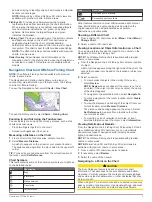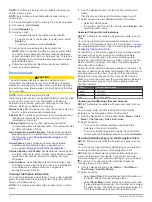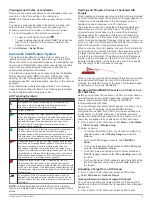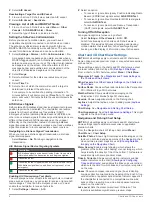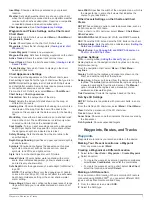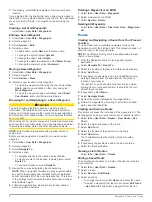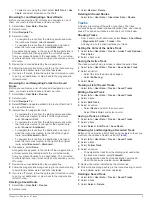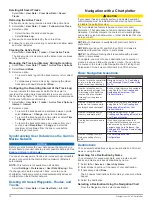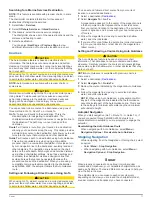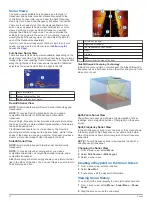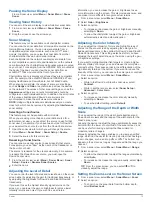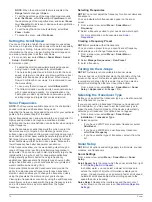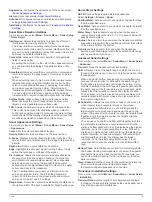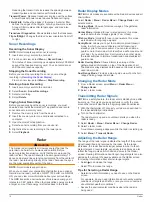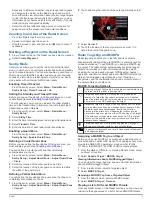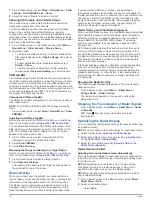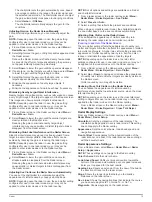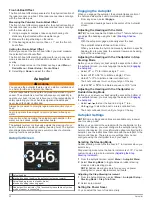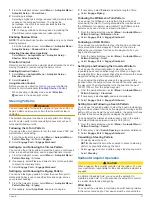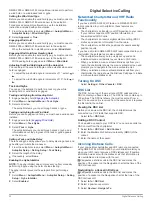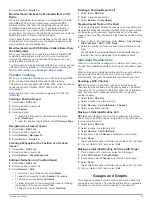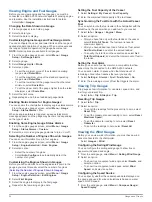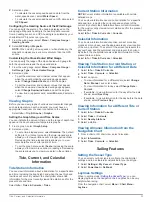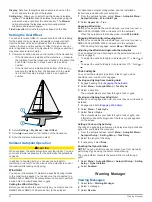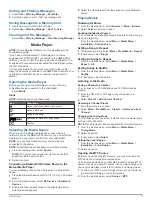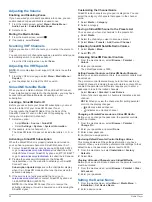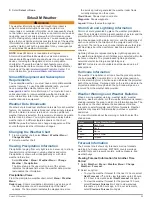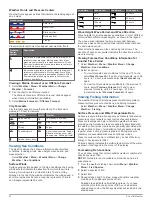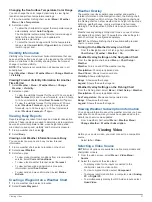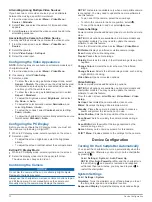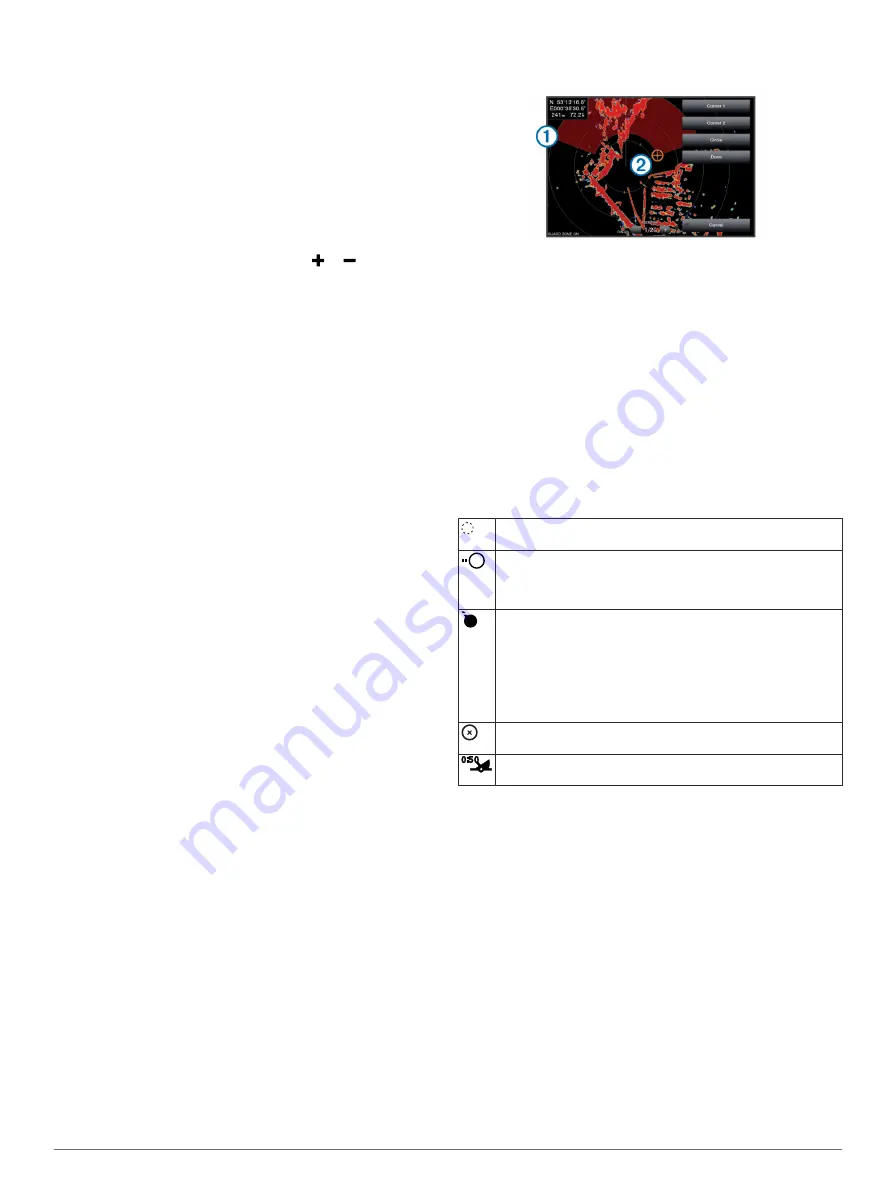
Especially in inclement weather, longer-range radar signals
can increase the clutter on the Radar screen and make it
more difficult to view information about shorter-range targets.
In rain, shorter-range radar signals can enable you to view
information about nearby objects more effectively, if the rain
clutter setting is configured optimally.
• Select the shortest effective range, given your reason for
using radar and the present environmental conditions.
Zooming In and Out of the Radar Screen
• Pinch two fingers together to zoom out.
• Spread two fingers apart to zoom in.
• Drag the screen to pan, and then select or to zoom, if
necessary.
Marking a Waypoint on the Radar Screen
1
From a Radar screen or the Radar overlay, select a location.
2
Select
Create Waypoint
.
Sentry Mode
Sentry mode allows you to put the radar into timed-transmit
mode, in which you can configure a radar transmit and standby
cycle to conserve power. You can also enable a guard zone in
this mode, which identifies a safe zone around your boat and
sounds an alarm when a radar object enters the zone. Sentry
mode works with all Garmin GMR model radars.
Enabling Timed Transmit
From the sentry screen, select
Menu
>
Radar Menu
>
Sentry Setup
>
Timed Transmit
>
On
.
Setting the Standby and Transmit Times
Before you can set the standby and transmit times, you must
).
To help conserve power, you can indicate the radar standby
time and the transmit time to implement periodic radar signal
transmissions at set intervals.
1
From the sentry screen, select
Menu
>
Radar Menu
>
Sentry Setup
.
2
Select
Stdby Time
.
3
Enter the time interval between radar signal transmissions.
4
Select
Transmit Time
.
5
Enter the duration of each radar signal transmission.
Enabling a Guard Zone
From the sentry screen, select
Menu
>
Radar Menu
>
Sentry Setup
>
Enable Guard Zone
.
Defining a Circular Guard Zone
Before you can define the boundaries of the guard zone, you
You can define a circular guard zone that completely
encompasses your boat.
1
From the sentry screen, select
Menu
>
Radar Menu
>
Sentry Setup
>
Adjust Guard Zone
>
Adjust Guard Zone
>
Circle
.
2
Select the location of the outer guard zone circle.
3
Select the location of the inner guard zone circle to define
the width of the guard zone.
Defining a Partial Guard Zone
You can define the boundaries of a guard zone that does not
completely encompass your boat.
1
From the sentry screen, select
Menu
>
Radar Menu
>
Sentry Setup
>
Adjust Guard Zone
>
Adjust Guard Zone
>
Corner 1
.
2
Touch and drag the location of the outer guard-zone corner
À
.
3
Select
Corner 2
.
4
Touch the location of the inner guard-zone corner
Á
to
define the width of the guard zone.
Radar Targeting and MARPA
Radar targeting enables you to identify and track objects.
Mini-automatic radar plotting aid (MARPA) is primarily used for
collision avoidance. To use MARPA, you assign a MARPA tag
to a target. The radar system automatically tracks the tagged
object and provides you with information about the object,
including the range, bearing, speed, GPS heading, nearest
approach, and time to nearest approach. MARPA indicates the
status of each tagged object (acquiring, lost, tracking, or
dangerous), and the chartplotter can sound a collision alarm if
the object enters your safe zone.
MARPA Targeting Symbols
Acquiring a target. Concentric, dashed green rings radiate from
the target while the radar is locking onto it.
Target has been acquired. A solid green ring indicates the
location of a target that the radar has locked onto. A dashed
green line attached to the circle indicates the projected course
over ground or the GPS heading of the target.
Dangerous target is in range. A red ring flashes from the target
while an alarm sounds and a message banner appears. After
the alarm has been acknowledged, a solid red dot with a
dashed red line attached to it indicates the location and the
projected course over ground or the GPS heading of the target.
If the safe-zone collision alarm has been set to Off, the target
flashes, but the audible alarm does not sound and the alarm
banner does not appear.
Target has been lost. A solid green ring with an X through it
indicates that the radar could not lock onto the target.
Closest point of approach and time to closest point of approach
to a dangerous target.
Assigning a MARPA Tag to an Object
Before you can use MARPA, you must have a heading sensor
connected and an active GPS signal. The heading sensor must
provide the NMEA 2000 parameter group number (PGN)
127250 or the NMEA® 0183 HDM or HDG output sentence.
1
From the Harbor, Offshore, or Cruising Radar screen, select
an object or location.
2
Select
Acquire Target
>
MARPA Target
.
Viewing Information about a MARPA-tagged Object
You can view the range, bearing, speed, and other information
about a MARPA-tagged object.
1
From a radar screen, select a targeted object.
2
Select
MARPA Target
.
Removing a MARPA Tag from a Targeted Object
1
From the Radar screen, select a MARPA target.
2
Select
MARPA Target
>
Remove
.
Viewing a List of AIS and MARPA Threats
From any Radar screen or the Radar overlay, you can view and
customize the appearance of a list of AIS and MARPA threats.
Radar
17

